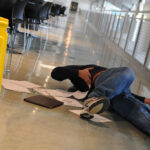
Were you seriously hurt on someone else’s property? If you’re thinking about putting together a slip and fall case, there are a few things you should know.
For example, although California tort law recognizes premises liability, injured parties are not always entitled to compensation. Whether you actually have grounds for a claim depends on the circumstances surrounding the accident.
Read on to learn more about the kinds of scenarios in which you can take action, as well as how to go about doing so, should you choose to proceed:
1. You Will Need to Establish a Dangerous Condition Existed Which Caused Your Injury
A dangerous condition such as a slippery floor, a broken handrail, bad lighting or other such dangerous condition that was responsible for your injury is the very first thing that you must establish as a Plaintiff in order to eventually prevail in a premises liability or slip and fall case.
2. You Will Have to Prove the Property Owner or Occupier Was Negligent
In California, personal injury actions are typically founded on negligence. That means for your slip and fall case to have a chance of success, you’re going to have to prove the owner or occupier owed you a duty of care (i.e., you were not trespassing at the time of the accident) and that they breached said duty by failing to take reasonable measures to maintain the premises.
Put another way, the liable party had constructive or actual knowledge of the hazard that caused you to slip and fall and failed to address it despite having the opportunity to do so.
2. You Will Have to Demonstrate the Extent of the Damages You’re Claiming
You can only seek compensation for the damages you can prove you actually incurred. As such, it’s imperative that you save all associated documentation. This might include medical records, hospital bills, payroll paperwork, and receipts for replacement services like meal preparation and housekeeping.
If you claim any non-economic damages like pain and suffering or diminished quality of life, you should also be prepared to present personal journal entries, statements from loved ones, and psych evaluations.
3. You Will Have Only a Limited Amount of Time to Proceed to Court
As long as it’s supported by lots of compelling evidence, there’s a good chance your claim will be settled. Should some kind of dispute arise, however, you’re going to have a limited amount of time to take the liable party to court.
California’s typical statute of limitations for personal injury action is two years. That means the average plaintiff has only two years from the date on which they were hurt to file a formal lawsuit.
For injuries that are not apparent right away, however, the two-year clock does not start ticking until the date on which the damage was discovered or should have been discovered through reasonable diligence. Since there are a few other exceptions like this one to the filing deadline, it’s advisable to get your slip and fall case underway as soon as possible.
Discuss Your Case with a Slip and Fall Attorney in Long Beach
Your Injuries Are Personal to Me
At the Law Office of Michael D. Waks, we know just how devastating slip and fall accidents can be. That’s why we’re determined to advocate for those who are seriously hurt in such scenarios.
If you want help with every aspect of your premises liability claim, you can count on attorney Waks, who has been practicing law for more than 38 years. Call (562) 206-1939 or submit our Contact Form to schedule a free initial consultation with a slip and fall lawyer in Long Beach.
- How Settlement Values Are Determined in California Personal Injury Cases - April 9, 2025
- How Can Evidence Be Preserved After a Personal Injury Accident - April 2, 2025
- How Do Emotional Distress Claims Work In Personal Injury Cases? - March 20, 2025